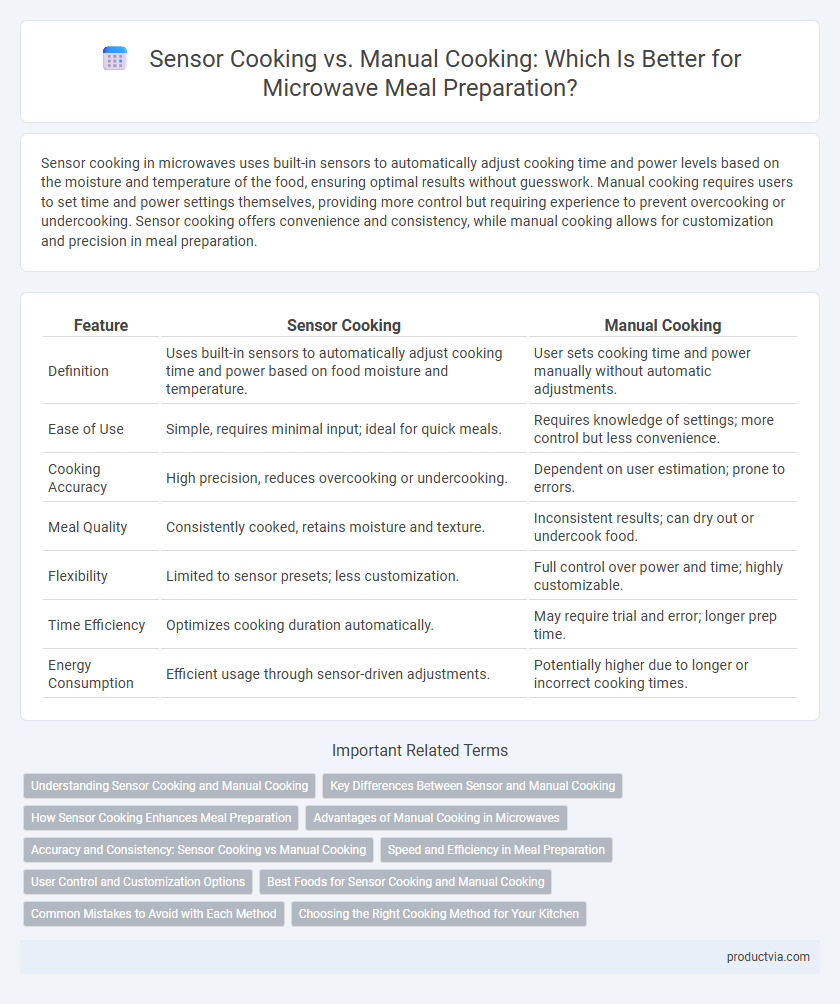Sensor cooking in microwaves uses built-in sensors to automatically adjust cooking time and power levels based on the moisture and temperature of the food, ensuring optimal results without guesswork. Manual cooking requires users to set time and power settings themselves, providing more control but requiring experience to prevent overcooking or undercooking. Sensor cooking offers convenience and consistency, while manual cooking allows for customization and precision in meal preparation.
Table of Comparison
| Feature | Sensor Cooking | Manual Cooking |
|---|---|---|
| Definition | Uses built-in sensors to automatically adjust cooking time and power based on food moisture and temperature. | User sets cooking time and power manually without automatic adjustments. |
| Ease of Use | Simple, requires minimal input; ideal for quick meals. | Requires knowledge of settings; more control but less convenience. |
| Cooking Accuracy | High precision, reduces overcooking or undercooking. | Dependent on user estimation; prone to errors. |
| Meal Quality | Consistently cooked, retains moisture and texture. | Inconsistent results; can dry out or undercook food. |
| Flexibility | Limited to sensor presets; less customization. | Full control over power and time; highly customizable. |
| Time Efficiency | Optimizes cooking duration automatically. | May require trial and error; longer prep time. |
| Energy Consumption | Efficient usage through sensor-driven adjustments. | Potentially higher due to longer or incorrect cooking times. |
Understanding Sensor Cooking and Manual Cooking
Sensor cooking technology in microwaves uses built-in humidity and temperature sensors to automatically adjust cooking time and power levels, ensuring food is cooked evenly and preventing overcooking. Manual cooking requires users to select specific time and power settings based on experience or recipe instructions, offering greater control but demanding more attention. Understanding the differences helps optimize meal preparation by balancing convenience and precision depending on the food type and cooking goals.
Key Differences Between Sensor and Manual Cooking
Sensor cooking in microwaves uses built-in humidity and temperature sensors to automatically adjust cooking time and power levels, ensuring optimal meal preparation without guesswork. Manual cooking requires users to set time and power settings based on personal judgment, which can lead to inconsistent results or overcooking. Sensor cooking enhances convenience and precision, reducing the risk of undercooked or overcooked food compared to traditional manual microwave controls.
How Sensor Cooking Enhances Meal Preparation
Sensor cooking in microwaves uses advanced moisture and temperature sensors to automatically adjust cooking time and power levels, ensuring perfectly cooked meals without guesswork. It enhances meal preparation by reducing overcooking and undercooking, preserving nutrients and flavors more effectively than manual cooking settings. This technology streamlines the cooking process, saving time and effort while delivering consistent, high-quality results.
Advantages of Manual Cooking in Microwaves
Manual cooking in microwaves offers precise control over cooking time and power levels, allowing users to tailor the process to specific recipes and ingredient textures. This method enables better customization, preventing overcooking or undercooking by adjusting settings based on real-time observation. Manual control also supports diverse cooking techniques such as defrosting, reheating, and simmering, which sensor cooking may inaccurately manage due to sensor limitations.
Accuracy and Consistency: Sensor Cooking vs Manual Cooking
Sensor cooking in microwaves leverages built-in humidity and temperature sensors to automatically adjust cooking time and power, ensuring precise and consistent meal preparation. Manual cooking relies on user input for timing and power settings, which can result in variability and potential undercooking or overcooking. Sensor cooking enhances accuracy by monitoring food conditions in real-time, delivering evenly cooked meals with minimal guesswork.
Speed and Efficiency in Meal Preparation
Sensor cooking technology in microwaves uses built-in sensors to automatically adjust cooking time and power based on the moisture and temperature levels detected in the food, significantly reducing meal preparation time compared to manual cooking methods. Manual cooking requires users to estimate cooking times and power settings, which can lead to undercooked or overcooked meals and longer preparation durations. Sensor cooking enhances efficiency by optimizing energy use and minimizing the need for monitoring, resulting in consistently faster and more reliable meal preparation.
User Control and Customization Options
Sensor cooking in microwaves offers precise user control by automatically adjusting cooking time and power based on humidity and temperature sensors, delivering consistent results with minimal input. Manual cooking provides extensive customization options, allowing users to set specific power levels and cooking durations tailored to individual preferences and recipes. Both methods enhance meal preparation efficiency, but manual cooking affords greater flexibility for complex or personalized dishes.
Best Foods for Sensor Cooking and Manual Cooking
Sensor cooking excels with foods that release consistent steam patterns, such as vegetables, rice, and frozen entrees, ensuring precise doneness without overcooking. Manual cooking provides flexibility for complex dishes like casseroles, baked goods, and meals requiring specific timing or texture control. Choosing between sensor and manual cooking depends on the food's moisture content and desired cooking precision.
Common Mistakes to Avoid with Each Method
Sensor cooking in microwaves often leads to undercooked or overcooked meals when the sensor misreads moisture levels, causing uneven heating. Manual cooking requires precise input of time and power settings, with common errors including setting cooking times too short or too long, resulting in food that is either cold inside or burnt outside. Avoiding these mistakes involves carefully monitoring food progress with manual settings and occasionally overriding sensor defaults for complex recipes to ensure optimal meal preparation.
Choosing the Right Cooking Method for Your Kitchen
Sensor cooking technology in microwaves uses built-in sensors to detect humidity and temperature, automatically adjusting cooking time and power for optimal meal preparation. Manual cooking requires selecting time and power levels based on recipe guidelines, offering precise control but demanding user expertise. Choosing sensor cooking enhances convenience and consistent results, while manual cooking allows customization for experienced users who prioritize fine-tuning.
Sensor Cooking vs Manual Cooking for meal preparation Infographic

 productvia.com
productvia.com